#peat moss potting soil
Explore tagged Tumblr posts
Text
To Pot or Not Pot, That is the Question
Its a hot, steamy day in Minnesota and even after torrential rains the past couple weeks, my plants need watering. The ones in pots are already setting up like cement. Today’s potting ‘soil’ has no soil in it at all. Most of them consist of sphaghum peat moss, coir fiber, perilite, vermiculite, sand, limestone, compost, compost wood chips and fertilizers. There are special soils for specialty…
#container plantings#fertilizers containers peat moss#peat moss potting soil#perennials bedding plants#planting in pots#Soiless potting soil#watering plants in containers#what&039;s in potting soil
0 notes
Text
god, I just want to sob
I looked and looked and looked and FINALLY was able to get a money tree and now it’s got root rot (pretty sure bc the trunks are getting squishy) and I’m about to move and I know the plant is going to be stressed and I’m worried that I’m going to lose my money tree. 😭😭😭😭😭😭😭😭😭
#personal#plant help#please#side note I HATE peat moss I can now say every plant I’ve had in that kind of soil has gotten infected#Also it started freaking RAINING when I was ready to go get a pot and supplies to work on this so now I have to wait even longer
0 notes
Note
can you talk about moss poaching i'm actually really curious
How can I refuse! Absolutely!!! It sounds kind of ridiculous, but it's actually very sad.
So, let's start off with some numbers. Every year, the moss black market is estimated to garner up to $165 million for trafficking approximately 82 million pounds of moss.
I cannot even wrap my mind around how much moss that is.
You might ask, why does moss poaching exist and why is it so lucrative? Well, the quality that has made mosses the prey of an illegal trade is simply their aesthetic appeal. Soft, velvety, and moist, mosses are extremely pleasant to the touch and calming to look at. Some people are willing to pay large amounts of money to collect them and put them in private gardens. However, most of the mosses that move in this underground black market are actually sold to companies/wholesalers for use in potting/gardening soil, plant nurseries, decor, and as craft materials. The majority of the preserved mosses in your run-of-the-mill chain craft store, planters, floral wreaths, or very-much-dead living wall decorations are gathered illegally, bleached to death, and then dyed green. This goes for a lot of prepackaged peat moss and soil mix blends as well.
Even though it is illegal to gather moss in public places (in the US, at least), people still harvest it. Why? Probably because there's a fair amount of money to be made and the consequences are very rarely enforced, and when they are, they are quite light--usually a $50 fine at worst if you're caught. Most of this black market moss is actually poached from the national park system, with Appalachia and the Pacific Northwest usually being the hardest hit regions.
Mosses play vital roles in many ecosystems, provide homes for threatened species, regulate water distribution in forests, and help with erosion, so their loss is a terrible blow. Additionally, moving such large quantities of mosses from one location to another may spread unwanted, invasive hitchhikers, like insects that lay their eggs in the plants, or even seeds and spores.
I'll end on this thought:
It can take 20 years for a small patch of moss removed from a fallen tree to grow back with the right moisture conditions.
How long would it take to regrow 82 million pounds?
6K notes
·
View notes
Text
While you can technically call sphagnum poss "peat moss," generally when people are referring to peat moss they are referring to peat.
Peat is what happens when organic material decomposes very very slowly. Bogs build peat, because they're super waterlogged and also there's no oxygen in the soil. It takes a very long time to accumulate in large amounts and is extremely absorbent. You'll frequently find it in potting soil.
Once it's cut out of the bog and dried out, it burns similar to coal. Selling this was absolutely important to many rural economies in Europe.
Unfortunately, this is very destructive towards the local ecosystem. I live in a (non-european) area where we used to have a bunch of little bogs, and now we have a bunch of little lakes where no bog plants can grow.
nature things that a lot of people don't know about and weren't even taught about adequately, but they're actually really fundamental and important to know about
how rivers work. Where do they get started? how do they decide which way to flow?? what makes one river muddy and the other one clear?
[They flow downhill. Always. If a river is flowing a Way, that way is Downhill. They start with rain flowing or soaking downhill until it forms into a little trickle through a channel like a gully or drainage ditch, and the farther it flows the more other trickles flow into it from the land around it, until you have a stream, and the streams all flow downhill until they run into each other, and eventually you have a river which finally reaches the ocean. Rivers never flow FROM the ocean because the ocean is the most downhill you can possibly go. I don't think rivers usually split in two—a fork in a waterway is usually two rivers joining together.]
[On the subject of pollution, rain is usually supposed to soak slowly through the layer of leaves, roots, and dead plant material that covers most biomes. But if you tear up the plants and leave bare mud, or replace a forest with a muddy cow pasture, there's no filter, and mud and contaminants wash into the river. Just plain mud can be pollution.]
how soil works. What makes different soils different? Why are some soils good for growing a garden and others terrible? Does it need more fertilizer?
[The sand, silt, clay diagram is very simplified and only deals with one aspect of soil. Roots, soil animals, fungi, and dead plant material are all part of soil and affect its structure, making it spongy and full of holes and passages for nutrients, water, and new roots. Tilling can break hard soil, but tilling doesn't make soil light, fluffy, and permeable—disturbing the soil as little as possible, protecting it with a layer of plant material, and allowing the natural life forms of the soil develop their networks and tunnels and slowly break down the plant material layer does. This is also very simplified. Soil is COMPLICATED.]
what fungi are, and whether they are dangerous.
[fungi cannot harm you unless you eat them or unless they're growing inside your house and you're inhaling their spores in a concentrated space. There's like, one species in Japan that causes skin irritation. You can touch any other species without any harm whatsoever. *Most* of them don't harm your garden either—in fact, most plants connect their root systems to the fungal mycelium in the soil and receive nutrients from the fungus in exchange for the products of photosynthesis.]
Whether lichen harm trees
[no. They're just hanging out. But a LOT of lichen on a tree might be a sign that the tree is dying. It's not the lichen's fault though.]
What moss is??
[it's a plant, but a very simple plant that doesn't have any vessels for transporting water, so it has to live somewhere damp and soak it up like a sponge. There are hundreds of species of moss, and different species live on the side of a boulder vs. the top, or a living tree trunk vs. a fallen dead tree trunk!]
where bugs go in the winter? I straight up had a book as a kid that told me that they just die, without explaining how the species doesn't go extinct if the winter kills them all.
[Tl;dr they're usually hibernating in fallen leaves and dead wood and plant material. Some do this as eggs or larvae/caterpillars; in this case the adults do die, but their children sleep peacefully through the winter to awake in the spring. And still others hibernate as adults. This is why you don't clean up your flower beds until late spring.]
How Many plants there are
[WAY more than you think]
How ecosystems work apart from "everything is out to get everything else and take resources from other organisms."
[Competition and cooperation are both important in ecosystems! Weeds are competitive and they can choke out other plants, but they also protect the soil from erosion and harsh sunlight, keeping it moist and helping organic matter to build up. A lot of plants, when they're young, need to be sheltered by other plants that protect them from dryness, heat, and herbivores. This isn't even getting into how some plants will send nutrients to seedlings or to understory plants in a forest! Before industrial agriculture made monocultures dominant, people used and were familiar with cooperative relationships between plants a LOT more.]
The range of creatures that are pollinators, and how important the variety is.
[Bees, wasps, butterflies, moths, flies, ants, beetles, hummingbirds, and bats are all pollinators, and flowers are usually shaped and colored and scented to attract particular pollinators. Bees can't do everything, and honey bees are only one kind of bee. Red flowers and long tube shaped flowers are often for hummingbirds, pale-colored flowers that open at night need moths, and flowers that give off strong foul odors often attract flies. It gets WAY more complicated than that—sometimes a flower is only pollinated by a single species of bee or wasp or beetle.]
How many bees there are besides honey bees
[LOTS. And you've probably never seen most of them, if you don't regularly spend time around native plants! There are 140 species of longhorn bee alone, and most people haven't even heard of longhorn bees! There are well over a hundred bumble bees too! Bees come in bright, metallic green, blue, and pure gold. In the USA where I live, some of the most endangered bees are the adorable, fluffy bumble bees—the American Bumble Bee is threatened, and we have some species, like the rusty-patched bumble bee, that are critically endangered.]
[Please, please, please do not use pesticides on plants unless it is a necessity, and please do a LOT of research on the specific pesticide you are using and its effects on non-target insects. If there is any alternative, Do Not Do It. ESPECIALLY not pesticides that come in dust or powder form, ESPECIALLY in the USA, because regulations are so loose here that regular people can buy pesticides in dust form that are horribly toxic to bees.]
[How horribly toxic? A pesticide like Sevin dust will cling to the fuzz on every single bee that visits your plant—like pollen—and those bees will probably die. And in social bees, before they die, they will take the poison back to their hive (like pollen) and potentially kill the entire hive.]
#but yeah I try to avoid potting soils that contain peat#and they will be listed as 'peat moss' 'sphagnum peat' or 'sphagnum peat moss'#unless is just says 'sphagnum moss' it's actually peat#source: special interest in bogs
10K notes
·
View notes
Text

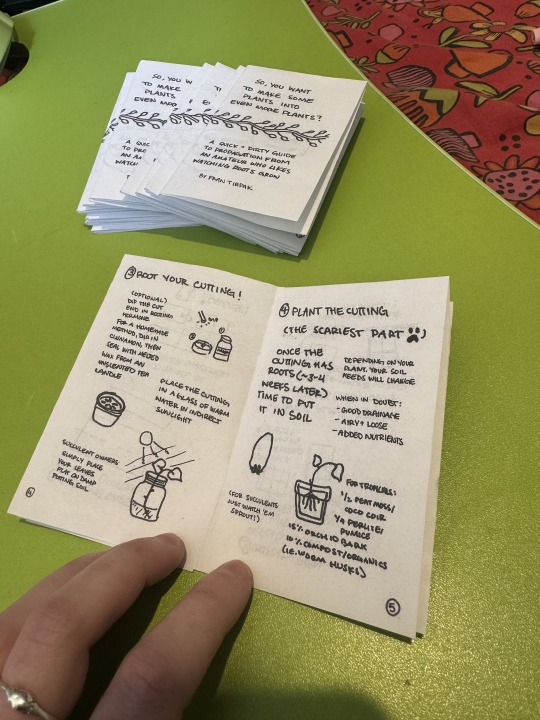
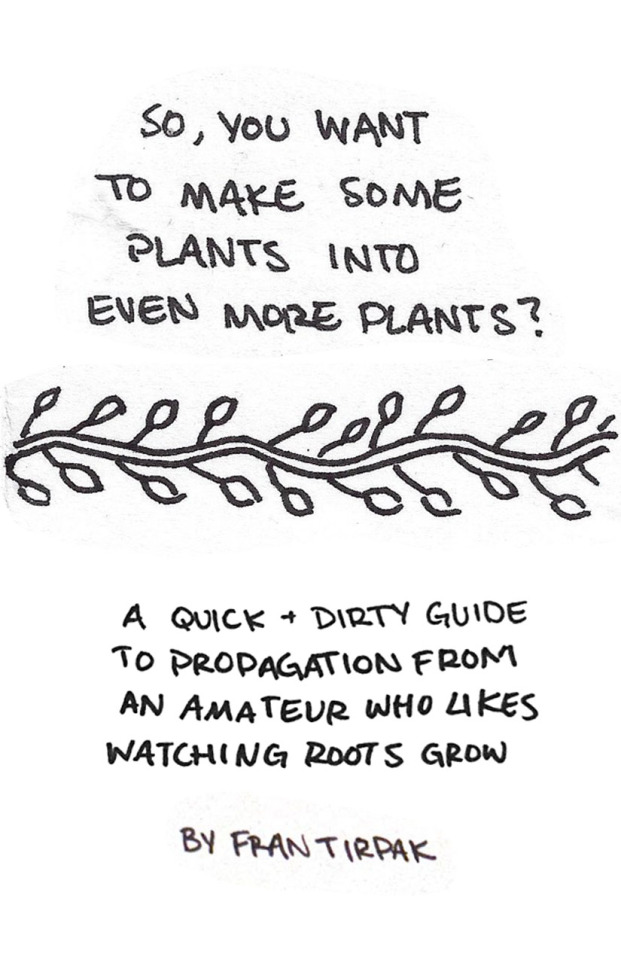


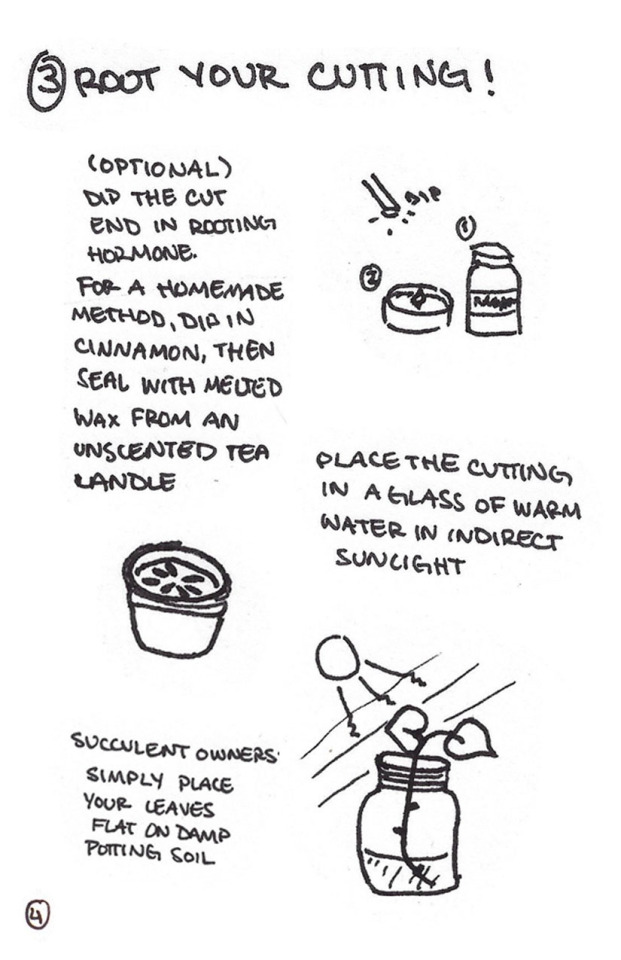
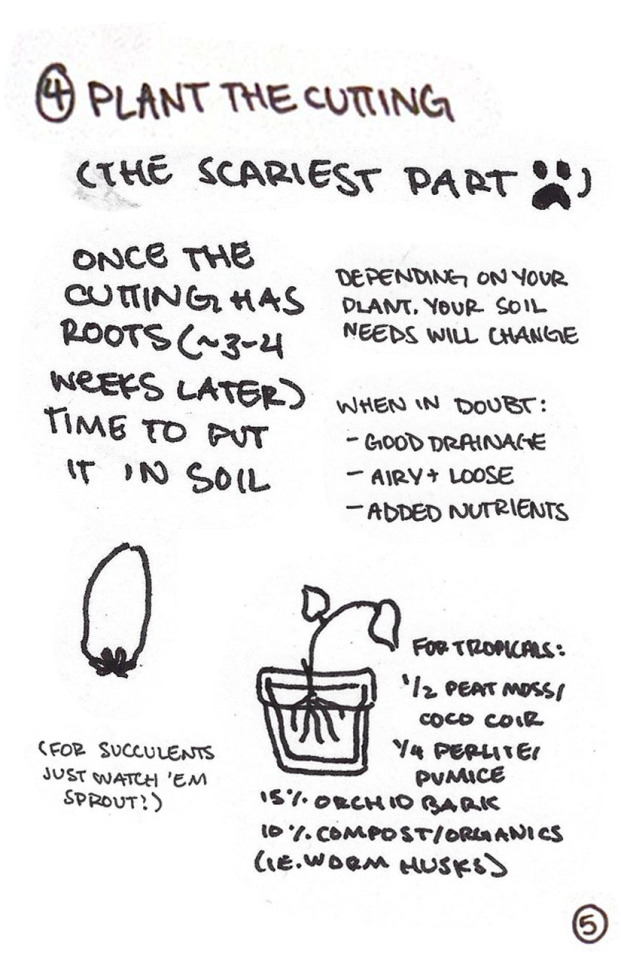
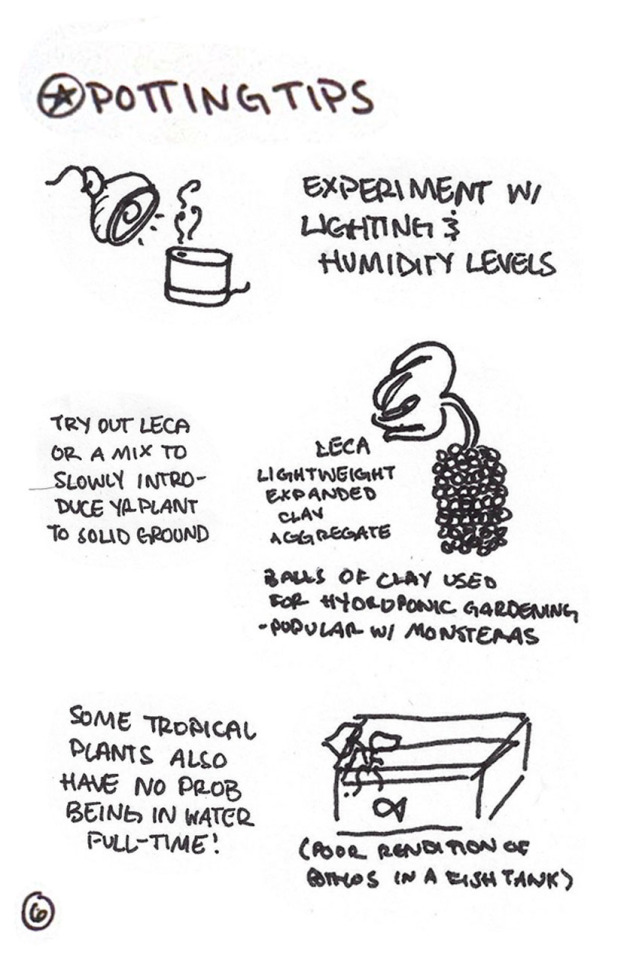
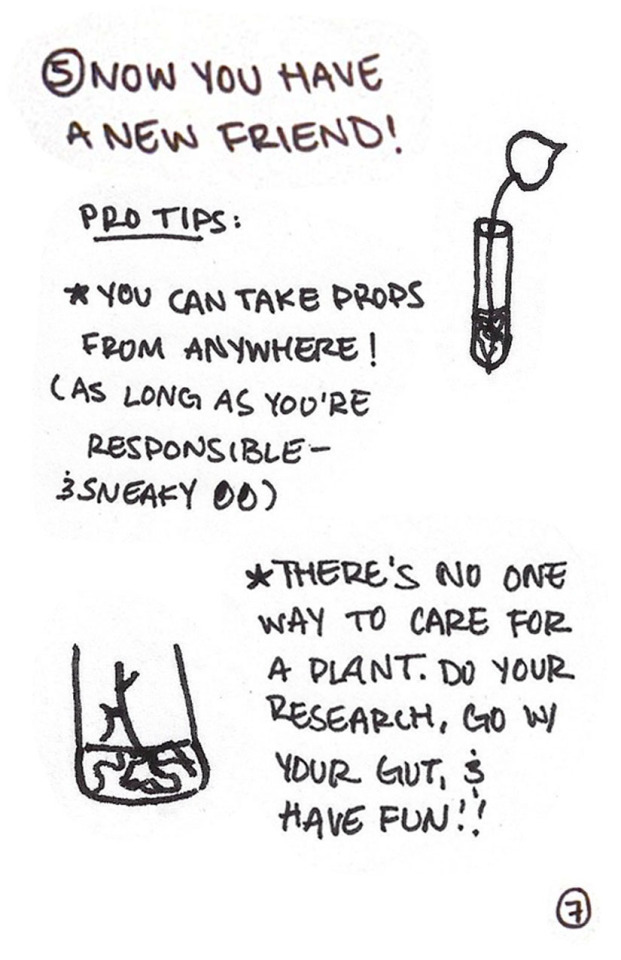

24-hour minizine (8 pages) about DIY propagation from leaf and stem cuttings (free to copy and distribute!! pls just take my name out if you change any content)
EDIT: thank you for all the love! check out @contentsunderpressurezine (instagram) for more of our stuff!
pdf download for print and read friendly versions on this ko-fi I just set up! pay what you wish, free to print and distribute
plaintext under the cut:
So You Want to Make Some Plants Into Even More Plants?
A Quick + Dirty Guide to Propagation from An Amateur Who Likes Watching Roots Grow. (by Fran Tirpak)
propagation - n.
"multiplication or increase, as by natural reproduction."
1. Prepare!
Important: Sterilize your shears w/ rubbing alcohol.
Wear gloves -- some plants can irritate your skin when cut.
Gather supplies: shears, gloves, soil medium, pot, glass jar.
Optional: plant food, rooting hormone, cinnamon, tealight.
^ we'll talk about these all more later on.
2. Take your cutting!
Succulents -- just pop off a leaf!
Vining plants (Pothos, Monstera), cut below one of the root nodes.
Woody stems (fiddle leaf, rubber plant) -- cut with 1-3 leaves at the top
3. Root your cutting!
(Optional) Dip the cut end in rooting hormone. For a homemade method, dip in cinnamon, then seal with melted wax from an unscented tea candle.
Place the cutting in a glass of warm water in indirect sunlight.
Succulent owners: simply place your leaves flat on damp potting soil.
4. Plant the cutting
(the scariest part)
Once the cutting has roots (~3-4 weeks later) time to put it in soil.
Depending on your plant, your soil needs will change.
When in doubt: good drainage, airy & loose, added nutrients.
For tropicals: 1/2 peat moss or coco coir, 1/4 perlite or pumice, 15% orchid bark, 10% compost/organics (i.e. worm husks).
(For succulents, just watch 'em sprout!)
* Potting Tips
Experiment with lighting and humidity levels.
Try out LECA or a mix to slowly introduce your plant to solid ground.
LECA: Lightweight Expanded Clay Aggregate. Balls of clay used in hydroponic gardening - popular with Monsteras
Some tropical plants also have no prob being in water full-time!
5. Now you have a friend!
Pro tips: You can take props from anywhere (as long as you're responsible -- and sneaky).
There's no one way to care for a plant. Do your research, go with your gut, & have fun!
134 notes
·
View notes
Text

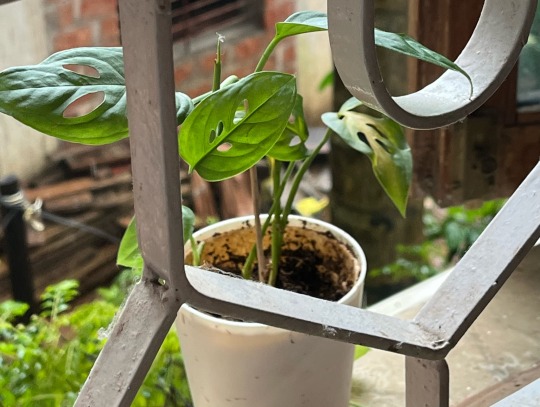
Monstera deliciosa 🪴
Information -
Kingdom: Plantae
Order: Alismatales
Family: Araceae
Genus: Monstera
Species: M. deliciosa
Monstera deliciosa, the Swiss cheese plant or split-leaf philodendron is a species of flowering plant native to tropical forests of southern Mexico, south to Panama.It has been introduced to many tropical areas, and has become a mildly invasive species in Hawaii, Seychelles, Ascension Island and the Society Islands. It is very widely grown in temperate zones as a houseplant.
It is called Swiss Cheese Plant due to their natural leaf holes. The Monstera plant's scientific name, Monstera deliciosa, derives from the Latin words "monstrum" meaning "monster" and "deliciosa" meaning "delicious."
Monstera plants are natural detoxifiers. Their broad leaves absorb and strip away indoor air toxins. The ideal temperature it requires is around 70°F. With a little humidity added to that, they get to feel right at home. Monsteras need bright light but do not tolerate direct sunlight. They can survive in low light, but their growth will be inhibited. To grow a striking Monstera plant with the lacy leaves and the coloration you adore, you need to provide it with good light. Monstera prefers bright indirect light. Keep out of direct sunlight for extended periods, as it can burn the leaves.
It is safe to come into skin contact with Monstera soil, foliage, and stems. However, it is not safe to ingest any part of the plant. Monstera is mildly toxic to humans and is toxic to cats and dogs but is not considered lethal. All parts of the plant are harmful to ingest except the fully ripe fruit, which rarely develops on indoor Monstera. The toxicity comes from insoluble oxalate crystals in the juices inside the plant. Indoor Monstera Deliciosa doesn’t yield fruits.
In various cultures, the Monstera has been a beacon of good luck, protection, and prosperity. It also fills spaces with positive energy and attracts good luck, according to Feng Shui.
Tips to grow and maintain Monstera:
Light: The plant thrives in bright and indirect light. It is advisable to keep it on a windowsill that receives good amount of indirect sunlight. Direct sunlight may burn its leaves. Note, if you find the leaves have small or no holes, then it means that the plant is not getting adequate light.
Soil:Use soil that retains moisture. Peat moss, perlite, and compost helps in the plant growth.
Watering: Ensure that Monstera Deliciosa is planted in a pot with good draining facility. The right time to water the plant is when the soil looks dry at the top. Note, overwatering may lead to root rot. During summers, the plant needs water regularly, however decrease the frequency of watering during winters.
Humidity: This plant grows well in humid conditions. You can mist its leaves or place it in a water tray having pebbles to increase the humidity level around it.
Temperature: Monstera Deliciosa grows well between 18°C and 29°C.
Support: As Monstera Deliciosa is an understory plant with aerial roots and large leaves, it needs support to grow.
Pruning: Prune the plant to maintain its shape. Remove yellow or damaged leaves so that the plant grows well.
Propagation: Monstera Deliciosa can be propagated through stem cuttings that can be rooted into water or directly planted into soil. You can also choose the process of air layering that involves creating a root system in a mature stem when it is still attached to the mother plant. Once roots are developed, the stem can be separated.
#plantblr#plantcore#plant photography#plants#plantbased#plant blog#monstera deliciosa#monstera plant#writerscommunity#spilled ink#dark academia#light academia#photographers on tumblr#photoblog#beautiful photos#photo#photooftheday#photography#leaves#green#naturecore#nature#planting#trees#flowercore#flowers#information#botany#biology#forest
23 notes
·
View notes
Text
Native Gardening: A Guide for Cold Stratification
It's nearly January, which means that it's time for me to start stratification for my native seeds.
Many native seeds have a built-in dormancy mechanism which will prevent germination until it is broken either naturally by weather, or artificially via cold/moist stratification in the refrigerator. This is a guide for the refrigeration method.
It's best done about 2-3 months before spring if you plan on starting the seeds indoors, or 2-3 months before your last frost date if sowing outdoors (depending on germination requirements). This year I'm using peat moss but you can substitute it with moist sand or damp paper towels.
Choosing Your Plants
One thing to consider before buying native seeds is how successful they will be once planted in your garden. The best way to determine this is by going outside and seeing what grows naturally in the yard.
For example, my yard has mostly shade-loving plants like the Common Blue Violet, Bloodroot, and Witchgrass, along with some hardier, more tolerant species like Blue Wood-Aster and Common Milkweed. Sun-loving plants like goldenrod are present but restricted to the edges of the property. Despite having no natural water source, I have seen a few water-dwelling species pop up as well.
This means that I have a pretty moist/shady backyard and that I should focus on species that either prefer these conditions or are very tolerant of them.
Remember to choose species that grow naturally in your biosphere. Some native seed vendors will provide range maps which will show you where certain plants exist in the wild. This is important because the entire point of native gardening is to support your local ecology and wildlife.
This year I'm raising Virginia Strawberry, Early Goldenrod, Sundial Lupine, Columbine, Spotted-Touch-Me-Not, Bloodroot, and Highbush Cranberry. In addition to pollinators like bees, wasps. and butterflies, these plants will be beneficial to songbirds, hummingbirds, and small mammals.
I always buy seeds from Prairie Moon Nursery. I've had great experiences with them and they even offer native range maps and germination instructions for each species.
Materials:

One bag of peat moss
A mixing bowl
A pitcher or measuring cup of water
Lidded jars or sealable plastic bags (1 per species)
A permanent marker and painters tape for labels.
Seeds of your choosing
Instructions:
Fill your mixing bowl with peat moss.
Slowly add water and mix with your hands until the moss is moist but not soaked. You should be able to form it into a ball.
Press peat moss into each container.
Sprinkle in the seeds. I covered the larger seeds with more peat moss, but the smaller seeds were just sprinkled on top so that I can actually find them when it's time to plant.
Seal containers and label each with the species name, length of time required in the fridge, (usually 60-90 days), and if it requires double dormancy.***
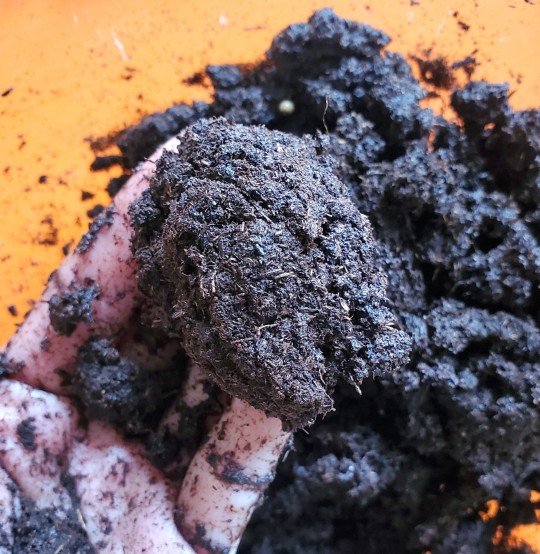



After this, place the containers in the fridge for 60-90 days, depending on the germination requirements. You should check on them weekly to make sure they don't dry out or grow mold. If a seed starts sprouting during stratification, remove it from the container and plant it in a starter pot.
After the 60-90 day period, the seeds will be ready to germinate. Move them into starter pots with soil or plant them directly into your garden bed.
I prefer starting my plants in Peat Pots, which are compostable and can be planted directly in the ground. This allows me to raise my seedlings indoors without the threat of wildlife or competition while preventing me from disturbing their root system when transplanting.
***Note on Double Dormancy
Some plants have double dormancy requirements for germination and can be more challenging to grow. This means that the plant will need a period of cold moisture, then warm moisture, and finally another period of cold moisture before they will germinate. Bloodroot, American Cranberrybush, and Spotted-Touch-Me-Not are all species that need double dormancy.
9 notes
·
View notes
Text

🍓🌱 Excited about growing your own organic strawberries right at home? 🌱🍓
Did you know you can grow delicious, pesticide-free strawberries even if you have limited space? 🍓🌿 Container gardening is the perfect solution! 🌞🏡
👩🌾👨🌾 Whether you're a seasoned gardener or just starting out, here are some tips for growing juicy strawberries in containers:
1️⃣ Choose a sunny spot: Strawberries love sunlight! Place your containers where they'll get at least 6-8 hours of direct sunlight daily.
2️⃣ Pick the right container: Opt for large containers with drainage holes to prevent waterlogging. Terra cotta or plastic pots work well.
3️⃣ Use quality soil: A well-draining, nutrient-rich soil mix (like compost and peat moss) is ideal for strawberries.
4️⃣ Planting time: Spring is perfect for planting strawberries. Space your plants about 8-12 inches apart to allow room for growth.
5️⃣ Watering and feeding: Keep the soil consistently moist, but not waterlogged. Feed your strawberries with organic fertilizer every 2-3 weeks.
6️⃣ Pest control: Keep an eye out for pests like slugs and birds. Netting can protect your berries while still allowing sunlight in.
➡️ Want to read my full article: How to Grow Organic Strawberries in Containers!
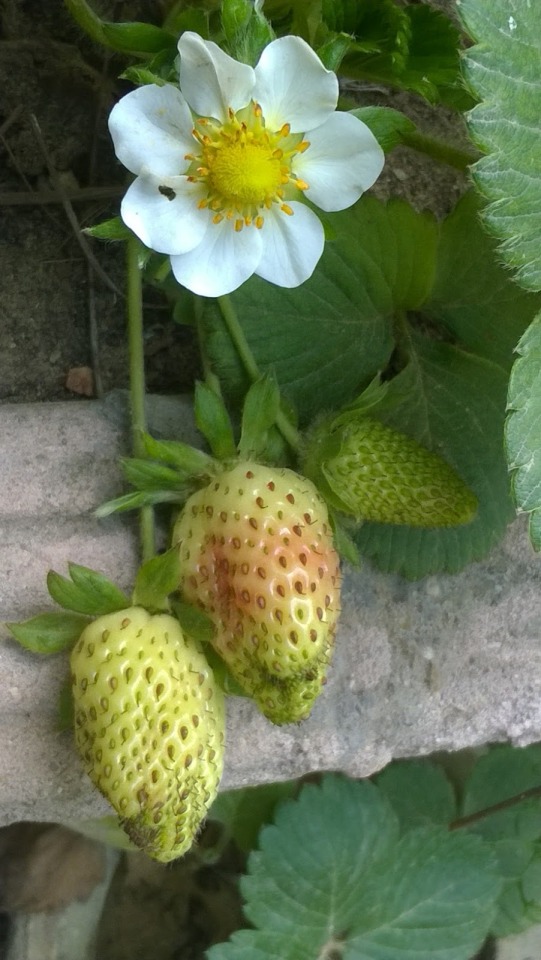
🎉 Growing your own strawberries is not only rewarding, but also a delicious way to enjoy fresh, organic fruit all summer long! Have you tried growing strawberries in containers? Share your tips and experiences below! 🍓💬
#gardening#garden#lovegardening#gardening tips#gyo#gardening uk#gardenchat#organic gardening#vegetable gardening#backyard#strawberry#strawberries#fruit#grower#growth#grow your own#grow your own food#gardens#gardenblr#gardencore#gardeners on tumblr#home and garden#my garden#potted garden#urban gardening#vegetable garden#plants#containergardening#container#container gardening
12 notes
·
View notes
Text
Itty bitty baby Ginko Biloba sapling I started from seed about 18 months ago graduated into a bonsai training pot today mostly because I cannot focus on anything else and even though it had plenty of room in the 4” pot it had it was still in its peat moss seed starting media still and having some real soil will be good for it (helloooo nutrients!)

I was really shocked at how tiny it’s roots are for something that’s had significant growing time at this rate, especially compared to the canopy. I’m not sure if this is typical of Ginko or a product of not having very good soil so far, but it seems healthy and happy overall anyway. They’re tough trees.

(That’s it, that’s all it has for roots)
I also suspect the seed wasn’t very good. It was one of 5 I started and the only one to germinate, when they’re easy enough that if they were sent to me healthy they should have all gone no problem. But here’s the one! I have other bonsai experiments going outside (with mixed results, all looking particularly haggard rn or maybe dead idk yet because of some terrible heatwaves) so no pictures of those, but this little one is so young and tiny it lives inside in my kitchen greenhouse window where I can keep a very close eye on it.

(I gave it a friend cx )
I decided to take the time to clean up the window just a little so y’all can see I uh.
Like plants. And have a few.

Finding the poor little Ginko is like playing Where’s Waldo 😅
#plant post#bonsai#Ginko tree#Ginko biloba#mako’s home jungle#this actually is only a small portion of my collection but it is the most densely packed portion and the generally healthiest right now#spoons and my personal health#along with the weather#have had a gnarly impact on some things sadly#I do my best
11 notes
·
View notes
Text
Im trying to become a better plant parent so I’m going to get a few doodads
Sol soil chunky potting mix - seems like a good peat moss free potting medium to have
Diatomaceous earth - because I think one of my plants has fungus gnats
Cinnamon - to try and get rid of the fungus in the soil that’s causing the fungus gnats
Leca balls - as a soil chunkifying additive
7 notes
·
View notes
Text

Thanks to @flashfictionfridayofficial for the prompt!
~
"Special delivery!" Wels called. He entered the little capsule in the cave, removing his breathing mask as the seal closed on the door and just getting a faint taste of sulfur on his lips. X hugged him and traded a cup of coffee and a stack of hardtack and jerkey for a new map and a little present wrapped in a ribbon. The "present" was a little soil and peat moss filled pot tied with a bow.
X cupped it, he set the pot of greenish fungus on the table, and watched as X arranged the beginnings of a tendril to climb the door frame. "Low water and sun needs, nice!"
"But you do seem to like cutting the schedule awfully close."
"Eh, no worries, I know how we take turns, I've just gotten sharper, and better at side trips. And we've got enough bread and water now." He added the latest and the map to his pack in the corner.
"Well, off to go Searching again." He continued, sliding on his now full sack, the coal-silk light and sturdy against the heavy load. He wandered upwards in the cave until he came to a new marker on the rock, a new part of the ruins, and a new slick warping of the air.
#flashfictionfridayofficial#flash fiction#flash fic#my writing#xisuma#evil xisuma#or minor mention in the background of#fluff#moon big#mcyt#hermitcraft season 8#hermitcraft
8 notes
·
View notes
Text
If you start from the idea that I’m quite insane this will all fall into place.

Darlingtonia for all its innocent appearance is really a muscle plant and left unsupervised for too long it will break out of its pot and run amok, terrorizing all the villagers for miles around. I remembered to take the first picture when the pot was 1/2 empty already but that is ok because only about 1/2 of this plant is going to survive this experience, I’ll be up sizing the pot they are in and there will still be to much to fit into the new pot. My potting medium is 2 parts perlite, 1 part vermiculite. If you want an acid buffer 1/2 part Peat Moss is optional. Measurements are by volume and approximate. I buy a pot without any drainage holes so I can install my own just a little more than 1/2 way up the side of the pot from the bottom or about 7 inches from the top rim of the pot which ever is less. The plants are easier to care for if they have a large reservoir to draw water from.

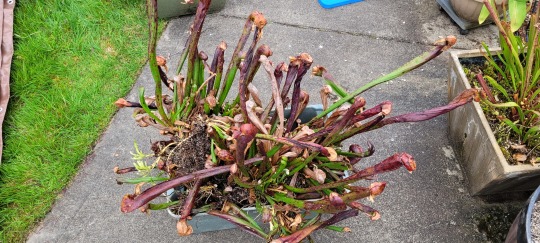
So these are the candidates for survival. The next step is to groom the candidates of all dead leaves.


As each plant is groomed I set it in the top of the new pot it will be moving into until the pot is +/- full



Once I have enough plants to satisfy my evil intentions I start pouring potting mix around the plants and water everything in well.
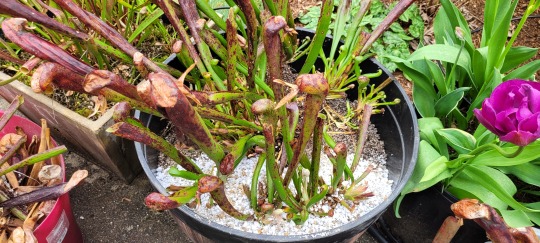
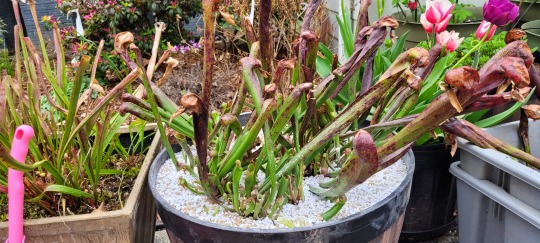
So these plants are on death roe. When I was 40 I would have potted them up in 1 and 2 gallon pots and sold them for $10.00 and $20.00 at a place I know in Seattle
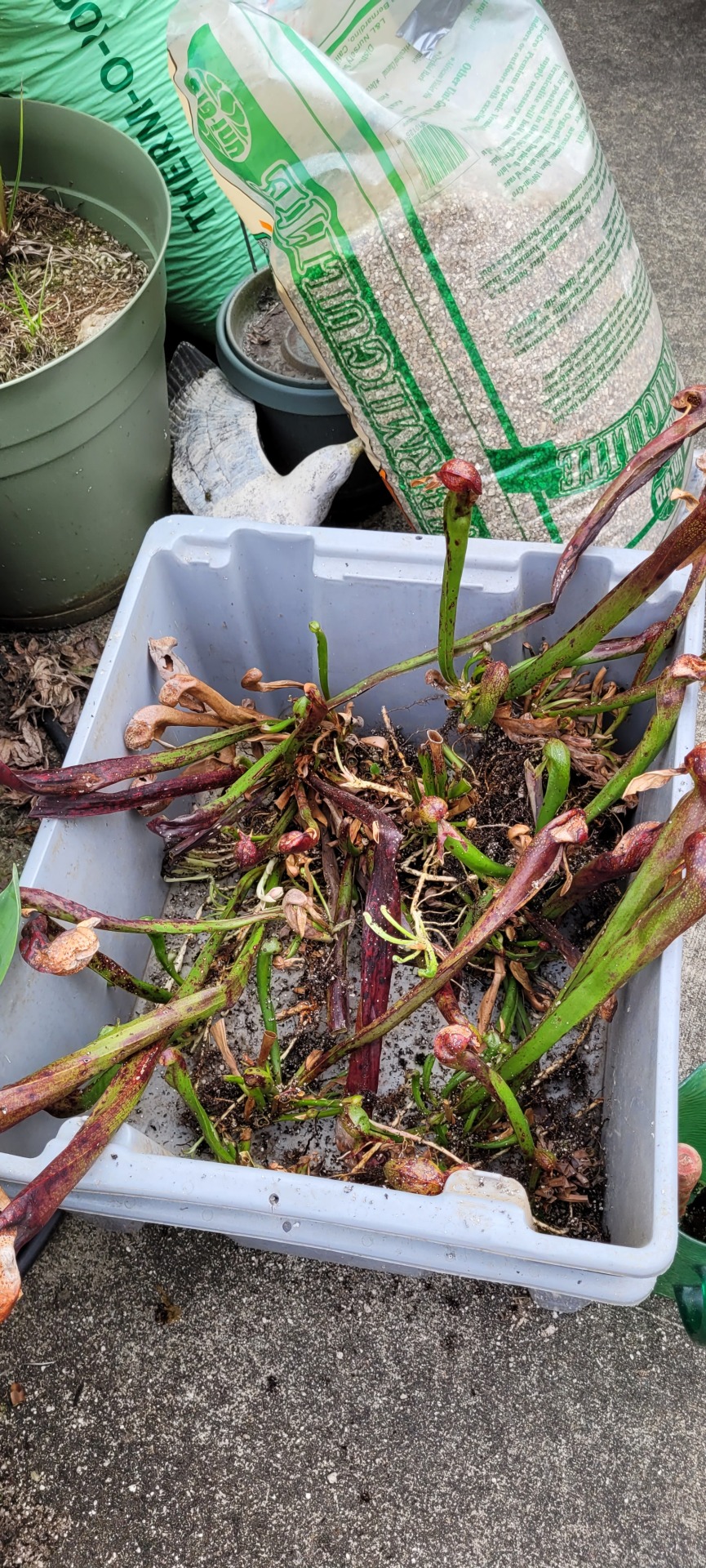
Most of them are already in the compost bin. I’ve left a few in a bucket of water on the off chance I can give them away but chances are no one I know will want them.
Tomorrow I have to mix some Drosera soil and plant my Aussie’s ( Drosera binata )
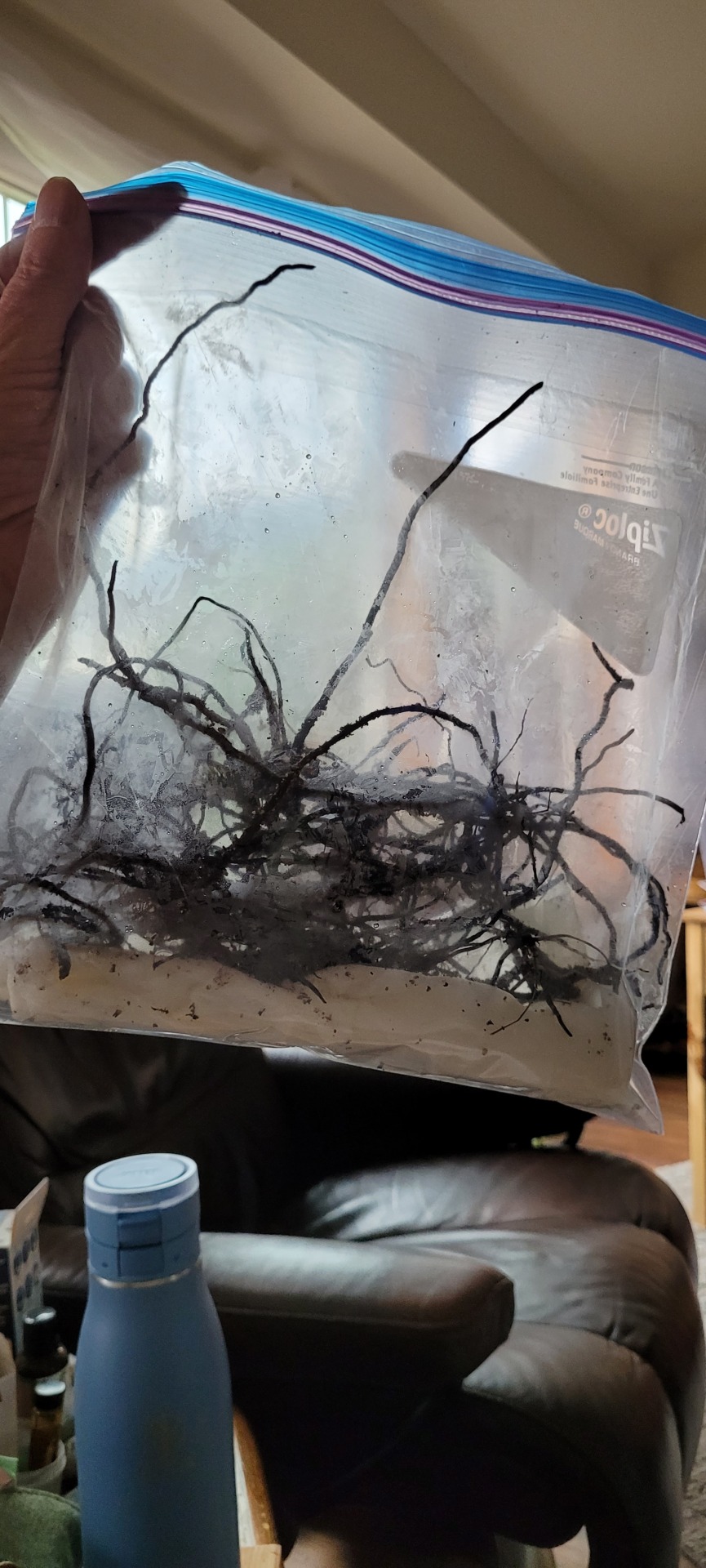
.
28 notes
·
View notes
Text
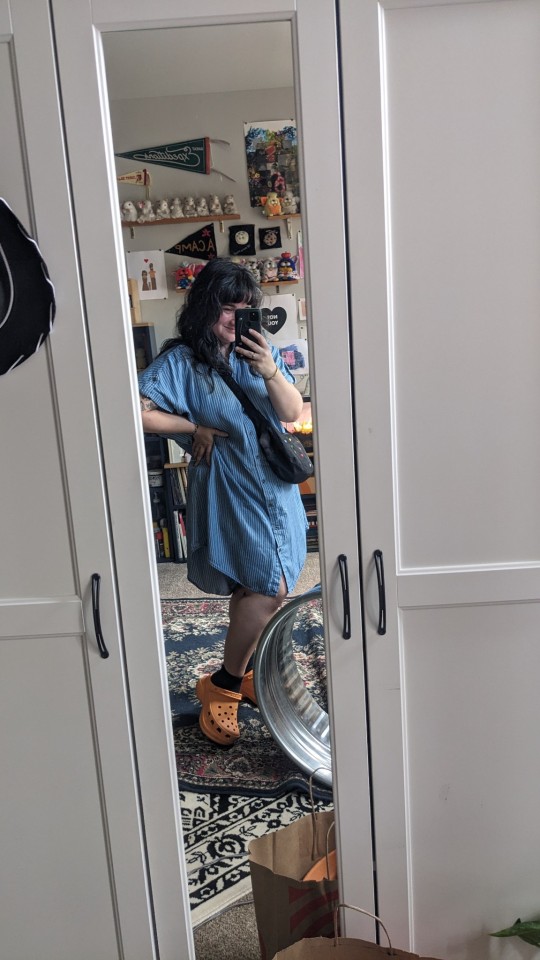


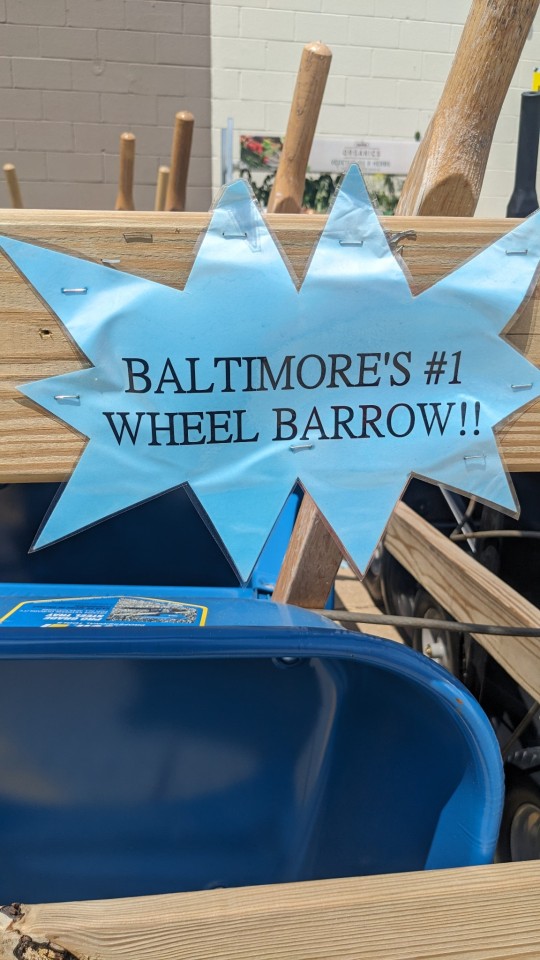

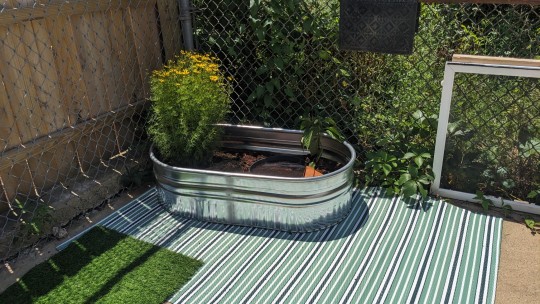

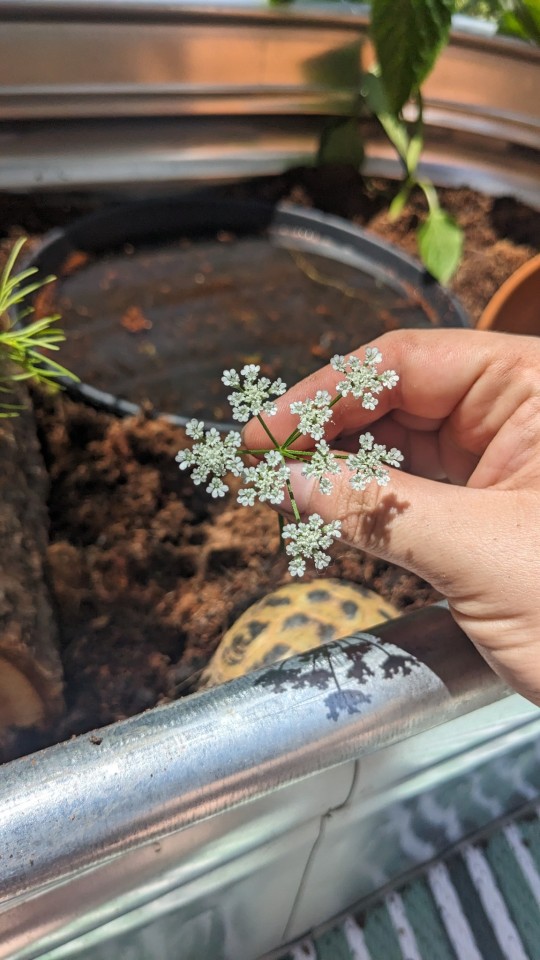

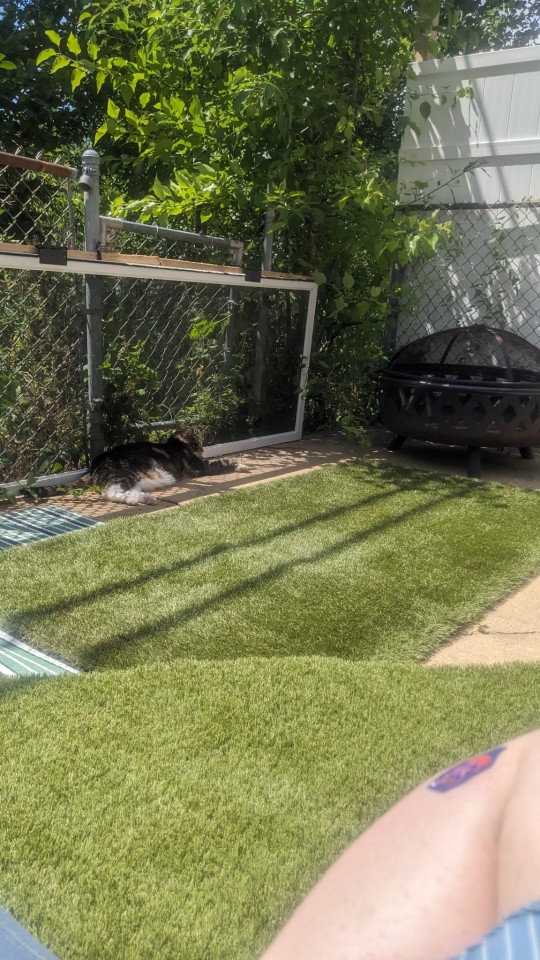
It is confusing my body that I have work tomorrow. Having Monday's off has been such a thing that it feels weird that I'm going to camp tomorrow. But even more it feels weird that other people will be there! Because camp is starting!
I have tried very hard to enjoy my day off. Me and James stayed up late talking and laughing and hanging out. It was a really nice evening and I would sleep really well. And I got to sleep in.
I woke up at 9 and I could have kept sleeping but I wanted to get up. I would go get washed and dressed. I felt pretty. It was going to be pretty sunny and warm but I had much to do!
I would feel a little dazed today. I don't know why. I feel very introspective and quiet. It's interesting for sure.
I would go downstairs and had a little breakfast. I had a toasted cinnamon raisin English muffin with butter. And gathered myself to go out.
My whole plan today was to get the supplies to build Crabcake's outdoor enclosure. I had a few ideas but I'm very happy with my final decision.
But I was getting frustrated. I would start my day out by going to five below to look for bar soap for camp. I have one but I wanted a backup. No luck though?? No soaps at all at that location.
I would get a blind bags and a snack. But then I was off. I walked across the parking lot to target. I would try our soda stream liquid there. And looked around at the clothes but I didn't want or need anything. I paid and went to my next stop.
Over to the Petco. I wanted to get a better hearing bulb. Which was a little confusing but I think I got a good one. Ceramic heating bulb. I would also get a hide and some extra food pellets and dried flowers for snacking. I had a nice conversation with the cashier. On my account Crabcake's name is Frank. But in talking to her it has been decided that his name is Crabcake Franklin Lentzwiler the first.
I would try to go to ace hardware next. But I kept having to drive in circles because of all the one way streets. I was struggling. I did finally make it inside but they didn't have anything I needed for my idea. So I felt dumb for all the driving in circles.
I would go to Aldi next. This Aldi did not have as many things as the Lidil did the other day. Disappointing but not surprising. It's funny how nice some of the Aldi and lidils are while other are so bare bones and you literally never know what you're going to get.
So I went to my final stop. I drove to Home Depot. And it wasn't perfect but it would work out in the end.
I was very frustrated when I could not find a staff member to help me. I found the tub I wanted but I couldn't safely pick it up off the pile without knocking everything over. But I circled the garden center 3 times before I gave up and went inside the main store and I found someone. And was like hey I know that it isn't your section but can you help me get something and he was surprised no one was available in the garden section but he was really kind and came and helped.
I would get two bags of peat moss topsoil, which is what was recommended online for tortoises. And then I chose a yellow flower plant and an egg plant plant a low dish and a terracotta pot. I was pretty happy with my choices.
The line took a long time. I chatted with the girl in front of me. She was super excited about my plan to make an enclosure garden for a tortoise. I was also very excited.
I paid and they offered to load the car for me but I decided that since I needed to get it all out of the car I should put it in myself. The guy thought that was funny.
I'm glad I did that though. Nothing was actually heavy it would just be a lot of thinking and moving things around.
I went home and got a parking space right in front of our door. Excellent. I came inside and put Sweetp in the basement. And brought everything inside.
I let Sweetp be free while I was working on setting up the tub. I had decided to get the tub without a bottom and so I would put a tarp down first. I used the two bags of top soil to cover that and then the two blocks of coconut fiber. I soaked everything and got it all mixed and set up and was pretty happy.
Both plants were pretty badly root bound. I had to chop some off of the flowers just to get it to break apart a bit. Pretty annoying. I really hope they don't die.
I got them planted and put in the other things I got. I filled the soaking tray. I half buried the pot as a hide. And I placed the log I got. It was time to introduce the boy.
Crabcake had been out when I left earlier. And he was still hanging out when I went to get him.
He is so stinking cute. I think this may have been the first time he was really outside. Born in captivity and such. So he seemed a little nervous when I put him in the tub but he has been exploring and hiding in the flowers and I am really excited that he seems happy in there. I want to grow chia for him to eat in there. I still need to figure out predator protection but for now, as a supervised activity I think it is all good.
Once I was done setting up and I had wash all the dirt off of my hands I would set up our camp chair out there and put the umbrella over it. I made nachos and set myself up to watch TikToks and eat my little lunch.
James asked me to water the plants so I did that. And sat down to eat. I opened my blind bags. Got a small dog dressed like a sorcerer named Justin. It was a good day.
I eventually got a little to hot and would move inside. I would go outside to check on Crabcake and Sweetp often. But I would also just hang out and eat snacks. It was honestly lovely. Though I got very sleepy.
James would come home at 5. And I would show them my hard work. I had asked them earlier in the day if we could go out to buy a porch swing this evening. And so after they changed their shirt and we brought all our animals inside, we would go out into the world.
We did not have luck at the first store. Disappointing. We still got a few small things. Pastries. We had to go to the Lidil I went to the other day. And they would have it! Amazing! James was very strong and carried it to the car. I was very happy.
But very quickly I fell apart. Callie let me know that some boys are trying to get the block house we want. Which upset me. And then we got to Mathews for dinner but they were out of pizzas??? I was so disappointed.
James pivoted and is still trying to cheer me up. We went to get pizza somewhere else but then their soda was flat and my stomach hurt so much and I was so upset. And it was worse that I knew I was being irrational. But I just feel all out of sorts.
I'm hoping eating helps. We are almost home. Where I will eat and try to be normal again. I was having a really good day and I would like to continue that.
Especially because I am very excited for camp tomorrow. I hope it's a really good day and I get a lot done.
I hope you all have a great night tonight. Take care of eachother. And be safe. I love you all. Goodnight!!
2 notes
·
View notes
Text
Fittonia Foliage Plants (Non-Flowering) Indoor
Fittonia Is A Genus Of Flowering Plants In The Acanthus Family Acanthaceae, Native To Tropical Rainforest In South America, Mainly Peru. The Most Commonly Grown Are F. Albivenis And Its Cultivars. They Are Spreading Evergreen Perennials Growing 10–20 Cm Tall.as A Tropical Plant That Naturally Grows In The Humid, Bright Shade Of Tropical Forests, This Plant Prefers Similar Conditions When Grown As A Houseplant. It Dislikes Full Sunlight, Preferring Bright, Indirect Sun.fittonia Grows Well In Standard Potting Soil With A Peat Moss Base. It Prefers A Slightly Acidic Soil Ph (6.5). The Soil Should Retain Some Moisture But Should Also Drain Well.keeping The Plant Appropriately Moist Can Be A Challenge. Nerve Plant Is Prone To Collapse If It’s Allowed To Dry Out. Although It Will Recover Quickly If Thoroughly Watered, Repeated Fainting Spells Will Eventually Take Their Toll On The Plant. At The Other Extreme, Fittonia Plants That Are Allowed To Stagnate In Water Will Develop Yellowed, Limp Leaves. Nerve Plant Thrives At Temperatures Around 70 F But Will Tolerate A Range From The Low 60s F To Low 80s F. These Plants Prefer Humid Conditions Similar To Those Found In Rainforests. Regular Misting Will Keep The Plants From Drying Out. Most Growers Find It’s Easiest To Grow These Lovely But Temperamental Plants In Terrariums, Bottle Gardens, Or Covered Gardens Where They Can Get The High Humidity And Diffuse Light They Love So Much. They Also Do Well In Steamy Bathrooms.during Its Growing Season, Feed Plants Weekly With A Weak Dose Of Liquid Fertilizer Formulated For Tropical Plants. A Balanced 5-5-5 Fertilizer Diluted To Half Strength Is A Good Formulation. Nerve Plant Grows Quickly In The Right Conditions, And If The Stems Grow Leggy, Pinching Off The Tips Will Keep The Growth Full And Bushy.nerve Plants Propagate Readily From Stem-tip Cuttings
3 notes
·
View notes
Text
How to Care for Christmas Cactus?

Christmas cactus has attractive leaves with beautiful flowers. Although the main roots of this plant go back to the tropics, you can buy it at any time of the year and grow it indoors as a houseplant. Christmas cactus is almost easy to care for and a little care is enough to see its colorful blooms on cold winter days and Christmas days!
In short, in order to take care of and maintain the Christmas cactus, we must say that During the care of the Christmas cactus to encourage the plant to flower more, grow your Christmas cactus as a hanging plant or place it in a place where there is enough space for the leaves to spread and hang. The good thing about the Christmas cactus is that, unlike most other cacti, you do not have to worry about its sharp blades when you touch it!
Christmas Cactus Light Requirements: What light is best for Christmas cactus?
Holiday cactus prefers relative shade or filtered light; Of course, this houseplant can quickly get used to other light and environmental conditions, but it is better to keep it in an environment with indirect light, so make sure you sufficiently provide the Christmas cactus light requirements.
However, if you want to expose it to direct sunlight, do so only during the winter months, as too much sunlight in the spring and summer can cause the plant to turn yellow and pale.
Christmas Cactus Watering: How often should you water a Charismas cactus?
This houseplant is a cactus, its tropical background makes it thirstier for water than its counterparts. So, water the Christmas cactus regularly during maintenance. The important thing to keep in mind when watering a Christmas cactus is to allow excess water to drain through the drainage holes under the pot when watering. In addition, the soil should be completely dry between waterings. Of course, if the soil is too dry, the leaves will begin to wilt and wrinkle.
Regarding how often you water your plant, it depends on the environmental conditions in which your Christmas cactus is kept. For example, during a hot and sunny summer, you should water the plant almost twice a week. Or, for example, if you put a Christmas cactus next to a skylight window in the winter, you may need to water it once a week.
To find out when your holiday cactus soil is dry and needs watering, dip your finger about 5 cm into the soil. If you feel the soil is dry, water the plant. Otherwise, avoid watering the plant, as overwatering will kill your cactus.
Christmas Cactus Soil: What is the best soil for a Christmas cactus?
Regarding the soil which is suitable for maintaining the Christmas cactus, we must say that the type of soil is not a vital factor for this houseplant. Christmas cactus has a high adaptability to different types of soil and can grow well in different soils. It is interesting to know that this plant grows in its original nature as an epiphysis (aerial).
However, in the case of holiday cactus soil, we can say that this plant can grow well in sandy, perlite-containing, potting (multi-purpose) and cactus-specific soils. For best growth, soil pH should be between 5.5 and 6.2. Therefore, peat moss can be a suitable additive to have an environment with more acidity.
Thus, it can be said that, soil is another basic and important issue so as to care for Christmas cactus.
Does holiday cactus like humidity?
Christmas cactus is one of the cacti that needs moisture to live, especially when it grows in dry areas or spends the winter in a warm environment. You can provide the required moisture for the holiday cactus by spraying water on the leaves or placing the plant pot on a tray containing water and pebbles. Just make sure the bottom of the pot does not come in contact with water. 50% humidity is enough for this plant. If the humidity is high, the risk of fungal diseases increases.
Christmas Cactus Toxicity: Are Christmas cactus poisonous to humans and pets?
This houseplant has little poison and children should not touch it. Its harmful effects can include nausea and diarrhea. In some cases, touching Christmas cactus may be a cause of depression, but no signs of poisoning have been reported after consuming this plant.
Yellowed, Spotted, or Wilting Leaves or Stems
As “yellowed, spotted or wilting leaves” is one of the common problems that you may face when you want to care for Christmas cactus, we will try to describe the reasons and the ways to solve it in details.
If you experience yellowing of leaves and stems, the appearance of spots on them or wilting of the plant, thoroughly examine the plant for the presence of thrips. Thrips are small, crab-like black-silver insects. Leaf and stem damage is not caused directly by thrips, but by viruses that are transmitted to the plant by these insects. If you notice thrips in your Christmas cactus, get rid of them with insecticide soap or garden oil.
It is better to remove the plant from its previous pot and plant it in a new and disinfected pot with fresh potting soil. In addition to thrips, wilting can be caused by lack of light, improper watering, or excessive root compression. Therefore, if you notice yellowing, spots or wilting of leaves and stems, consider these cases and make the necessary changes.
#houseplants#houseplant#houseplantcare#houseplant_care#careforhouseplants#care_for_houseplant#care_for_houseplants#care_of_houseplant#take_care_of_houseplants#takecareofhouseplants#plants#plant#Christmas_cactus#caring_for_Christmas_cactus#care_for_Christmas_cactus#take_care_of_Christmas_cactus#holiday_cactus#care_for_holiday_cactus
10 notes
·
View notes
Text




Calathea ornata
Information:
Common Name: Pinstripe plant, pinstripe calathea Botanical Name: Goeppertia ornata (formerly Calathea ornata) Family: Marantaceae Calathea ornata, also known as the pinstripe plant, is a tropical houseplant and is considered one of the most elegant types of calatheas. It's known for its wide, pointed dark green leaves marked with sets of thin stripes in creamy white or pink. The pinstripe plant grows best in bright, indirect light, moist soil, temperatures between 65 to 85 degrees Fahrenheit, and high humidity.
Tips to Care and Maintain Calathea ornata:
Give this plant adequate bright light to thrive.
Water the plant regularly so the soil stays lightly moist but not soggy.
Use a peat-based potting soil
Fertilize monthly throughout the growing season.
Light: Give your Calathea ornata medium to bright indirect light. This plant is a great option for a north-, east-, or west-facing window; the harsh direct light of a south-facing window can be too strong.
Soil: Calathea ornata will grow best in a loose, well-draining potting mix that holds onto moisture. A peat-based mix is ideal—you can make your own by combining 2 parts peat moss, 2 parts orchid bark, 2 parts perlite, and 1 part organic compost. Some growers prefer to use a ready-made potting mix designed for African violets for their calatheas.
Water: Water your Calathea ornata consistently so that the soil stays moist but not soggy. Overwatering can cause root rot, which can kill the plant. Avoid letting the soil dry out beyond the top inch or so between waterings.
Temperature and Humidity: Keep this tropical plant in a place with moderate temperatures and lots of humidity. If your space is particularly dry, group your plant in with other plants in your collection to help create a more humid microclimate, or run a humidifier nearby to add moisture to the air.
Fertilizer: Feed your Calathea ornata with an organic liquid houseplant fertilizer diluted to half strength every two weeks during spring and summer. Stop fertilizing in the fall, when the plant goes dormant for the winter. Resume fertilizing the following spring.
Pruning: Use sharp, sterilized shears or scissors to cut away any brown or shriveled leaves at the base to keep your Calathea ornata looking healthy. You can also trim away any browned or dried-out leaf margins while leaving the rest of the leaf on the plant. Take care not to cut away more than about a third of your plant's leaves to avoid damaging its growth.
How to Treat Pests
Calathea ornata generally isn't prone to many issues but it can be affected by houseplant pests like spider mites, thrips, whiteflies, and scale. The best way to avoid pests is to prevent them with a few best practices: Examine plants carefully for signs of pests before buying, quarantine plants that show signs of an infestation, and keep an eye on your plants to spot pests and eliminate them early. Treat insect pests with organic pesticides like neem oil or remove them with horticultural soap. Cut away badly affected portions of the plant, bag them up, and put them in the trash outside to keep them from affecting your other plants.
Common Problems With Calathea Ornata
Calatheas aren't the easiest houseplants to please, but most issues can be remedied by adjusting the plant's environmental conditions or watering more consistently. Here are some common problems with Calathea ornata and their causes.
Curling Leaves: Curling leaves are your plant's way of telling you it needs a drink. If your plant's leaves are curling, give it a good soaking. Keep an eye on the soil moisture to avoid drying out.
Leaves Turning Brown: Browning leaves can indicate a few different issues, including cold drafts, dry air, or too much sun. Consider your plant's conditions and make adjustments.
Leaves Turning Yellow: Yellowing leaves can mean your plant is getting too much water. In severe cases, they can be a sign of root rot. Cut back on watering immediately. If that doesn't help, repot your plant in fresh soil and cut away any black, rotten roots in the process.
#plantblr#plantcore#plant blog#naturecore#nature#plant photography#plants#plantbased#calathea ornata#botany#studyblr#biology#leaves#stripes#writerscommunity#spilled ink#dark academia#light academia#writers on tumblr#information#informative#shitpost#green#home decor#organic#photographers on tumblr#beautiful photos#photoblog#photooftheday#photography
24 notes
·
View notes